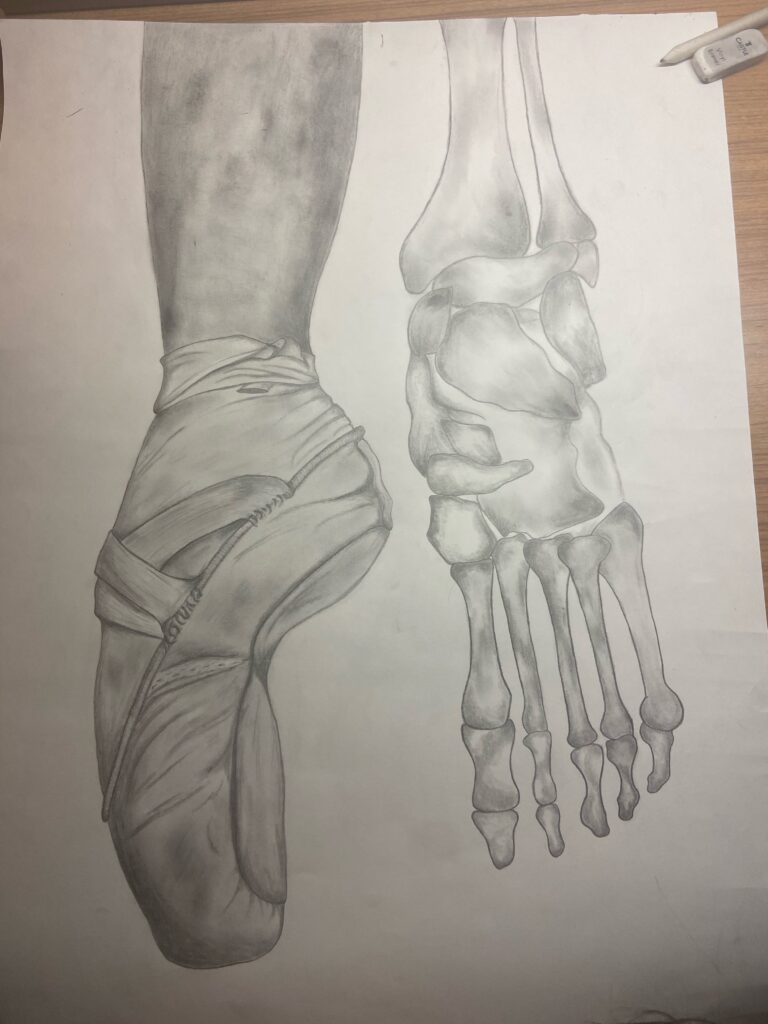My STEAM project is based on knowing the stages of bone development and repair and how it correlates to the effect ballet has on the development of dancers feet. The mediums I used in my abstract include graphite and charcoal. I used these things to create an outside and inside view at ballet dancers feet.
Ballet is an extremely competitive environment. Many dancers begin at a young age when the bones are still developing themselves. Ballet alters the development of their feet because unnatural movements not meant for human bodies and abnormal stances exert pressure on those bones leading to deformity. Ballet exerts a ton of pressure specifically on the foremost bones that are located in the toes. This pressure causes the bones to develop stunted or curved. The bones in the feet, while somewhat flexible, were not created to uphold and support someone’s entire body weight. Incorrect form will create a slant within the bone alignment of the metatarsals without proper support. This leads to premature arthritis and deformation of the feet. The bones of the feet begin to suffer from major deformation and stress fractures. (Hale, 2022)
Pressure that dancers feel fosters the feeling of obligation to do specific things to perform at peak condition. This is why eating disorders are a common occurrence in the dance industry. Bones development, healing, and reconstruction depends on a good diet. When dancers deprive themselves of necessary nutrition required to boost bone health such as calcium, this diminishes the bones. This lack of calcium stimulates the activity of osteoclasts which break down bone while the osteoblast activity remains consistent, unable to create bone as fast as osteoclasts are breaking it down. This results in a lower bone density and higher rates of fractures. (Amorim et al., 2014)
Studies have found that dancers who are older and past puberty are known to be less likely to have deformations within their feet in comparison to dancers who started off earlier. Starting early is encouraged within the dance community despite how hurtful it can be to one’s development. While male dancers do experience a great amount of strain, they receive a considerably less amount of injuries. This is because they do not dance on their toes, and typically have a better diet. Men also naturally have a higher bone density and amount of cartilage. (Hewette & Tufano 2022)
In conclusion, ballet has major effects on bone development due to the pressure it induces both mentally and physically. While graceful looking, there are a plethora of things that dance causes and promotes such as eating disorders, stress fractures, and deformity within bone development. The constant wear and tear on the bones cartilage eventually becomes the reason dancers retire so early within their careers. While not reversible, this could all be avoided by taking caution at what age the dancer begins, proper technique, and dependable pointe shoes, as well as maintaining a healthy, consistent, diet. (Albisetti et al., 2009)
Reference
Amorim, T. P., Wyon, M., Maia, J., & Machado, J. C. (2014, October). Prevalence of low bone mineral density in female dancers. Research Gate. Retrieved July 30, 2022, from https://www.researchgate.net/publication/266401083_Prevalence_of_Low_Bone_Mineral_Density_in_Female_Dancers
Hale, D. S. (n.d.). How do ballet dancers’ feet change? Foot & Ankle. Retrieved June 30, 2022, from https://www.footankle.com/how-do-ballet-dancers-feet-change/
Hewette, E., & Tufano, J. J. (n.d.). Bone Health in female ballet dancers: A review – researchgate. Research Gate. Retrieved July 30, 2022, from https://www.researchgate.net/publication/289540939_Bone_health_in_female_ballet_dancers_a_review
Wewege, M. A., & Ward, R. E. (2018, March 2). Bone mineral density in pre-professional female ballet dancers: A systematic review and meta-analysis. Journal of Science and
Medicine in Sport. Retrieved July 30, 2022, from https://www.sciencedirect.com/science/article/pii/S1440244018300586


This article created by Jaylene Villamor explains the major causes that deform ballet dancers’ feet. Starting dance at a younger age can create a big impact on how the feet grow in an unfamiliar stance to the human body. The stance of a ballet dancer involves them being literally on their toes. Since the ballet industry strives for everything to look graceful and perfect in many ways, it creates a stigma for the dancer to look elegant while dancing. With that being said, it is very much pragmatic that always practicing on your toes at a younger age will allow those metatarsals in your feet to become accustomed to how they are pressured to be positioned. This can cause arthritis to start prematurely in those who start ballet dancing at a young age, commonly in females. Females are more susceptible to injury and/or complications due to dancing because their bodies are not built to take on harsh impact, unlike males. Males have less chance because they are made to withstand many harsh impacts and are able to do a lot of harsh activities without much damage. There are factors that can cause bones to wear and tear much more easily. The ballet dancing industry glorifies looks and appearance. That can lead to harmful mental illnesses including eating disorders. The bones need macronutrients in order to function correctly and have a stable-strong structure to hold themselves and the body up. Since the body is receiving poor nutrients, the bones are more prone to being injured. With all being said, ballet dancing has its quirks and works, but there is always a downside to every lifestyle. Ballet dancing can cause a myriad of problems for the dancer physically, mentally, and environmentally.